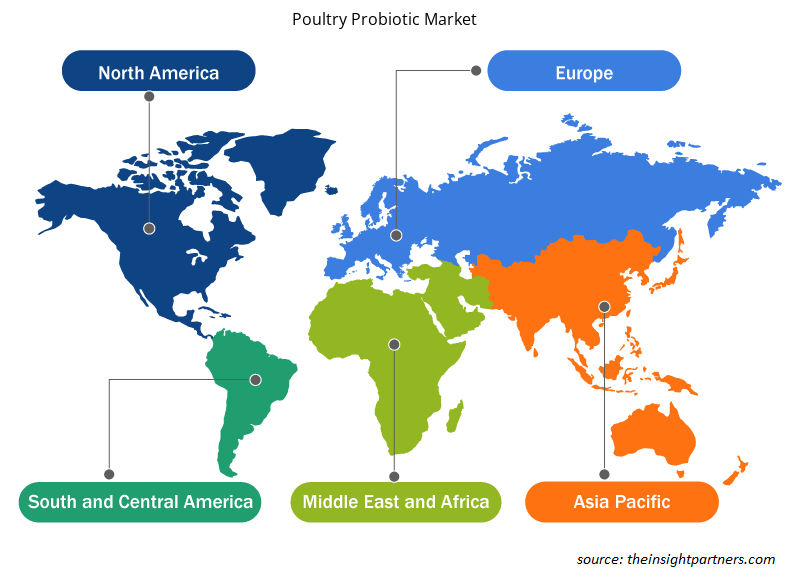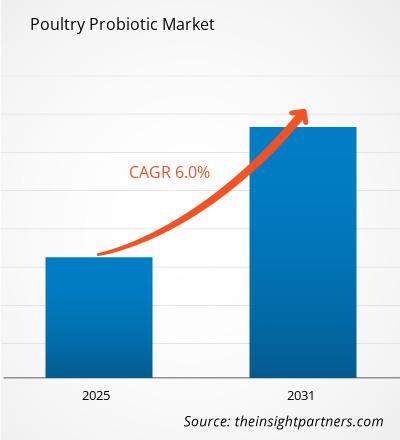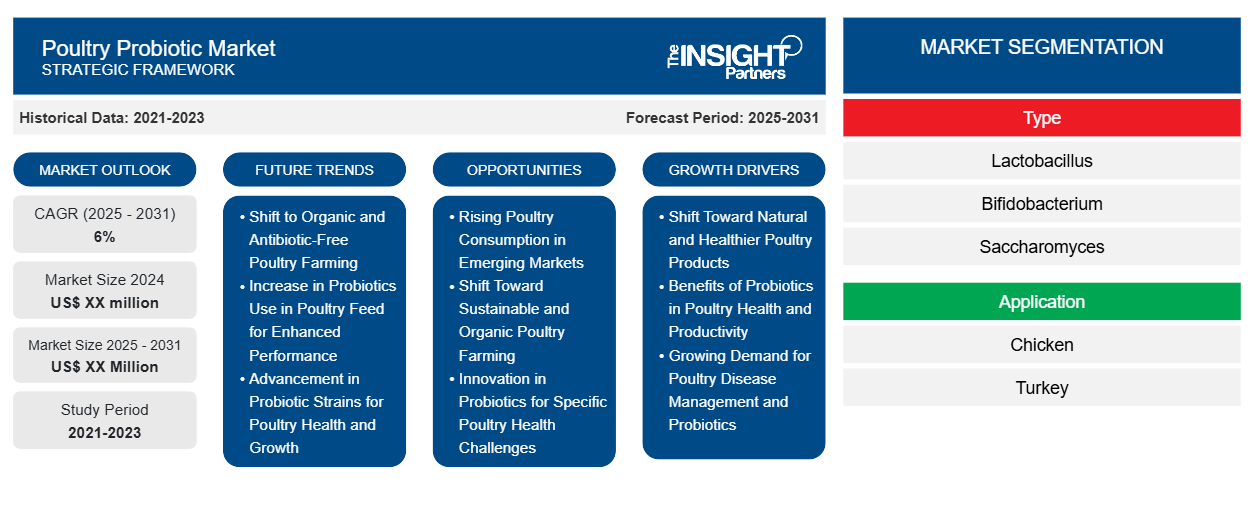Der Markt für Geflügelprobiotika wird voraussichtlich von 2024 bis 2031 eine durchschnittliche jährliche Wachstumsrate von 6 % verzeichnen, wobei die Marktgröße von XX Millionen US-Dollar im Jahr 2024 auf XX Millionen US-Dollar bis 2031 wachsen wird.
Der Bericht ist nach Typ (Lactobacillus, Bifidobacterium, Saccharomyces, Streptococcus und andere) segmentiert. Der Bericht präsentiert außerdem Analysen basierend auf der Anwendung (Huhn, Truthahn und andere). Die globale Analyse ist weiter auf regionaler Ebene und nach den wichtigsten Ländern aufgeschlüsselt. Geografisch ist der Markt in Nordamerika, Europa, Asien-Pazifik, Naher Osten und Afrika sowie Süd- und Mittelamerika unterteilt. Der Bericht bietet den Wert in USD für die oben genannte Analyse und Segmente.
Zweck des Berichts
Der Bericht „Poultry Probiotic Market“ von The Insight Partners zielt darauf ab, die aktuelle Situation und das zukünftige Wachstum sowie die wichtigsten treibenden Faktoren, Herausforderungen und Chancen zu beschreiben. Dies wird verschiedenen Geschäftspartnern Einblicke geben, wie zum Beispiel:
- Technologieanbieter/-hersteller: Um die sich entwickelnde Marktdynamik zu verstehen und die potenziellen Wachstumschancen zu kennen, damit sie fundierte strategische Entscheidungen treffen können.
- Investoren: Durchführung einer umfassenden Trendanalyse hinsichtlich der Marktwachstumsrate, der finanziellen Marktprognosen und der Chancen entlang der Wertschöpfungskette.
- Regulierungsbehörden: Zur Regulierung von Richtlinien und Überwachungsaktivitäten auf dem Markt mit dem Ziel, Missbrauch zu minimieren, das Vertrauen der Anleger zu bewahren und die Integrität und Stabilität des Marktes aufrechtzuerhalten.
Marktsegmentierung für probiotische Geflügelprodukte
Typ
- Lactobacillus
- Bifidobakterien
- Saccharomyces
- Streptokokken
Anwendung
- Huhn
- Truthahn
Passen Sie diesen Bericht Ihren Anforderungen an
Sie erhalten kostenlos individuelle Anpassungen an jedem Bericht, einschließlich Teilen dieses Berichts oder einer Analyse auf Länderebene, eines Excel-Datenpakets sowie tolle Angebote und Rabatte für Start-ups und Universitäten.
- Holen Sie sich die wichtigsten Markttrends aus diesem Bericht.Dieses KOSTENLOSE Beispiel umfasst eine Datenanalyse von Markttrends bis hin zu Schätzungen und Prognosen.
Wachstumstreiber auf dem Markt für Probiotika für Geflügel
- Umstellung auf natürliche und gesündere Geflügelprodukte: Die wachsende Vorliebe der Verbraucher für natürlichere und gesündere Geflügelprodukte führt zu einer Verringerung des Einsatzes von Antibiotika in der Geflügelproduktion. Eine Alternative zum Einsatz von Antibiotika, nämlich ein Probiotikum für Geflügel, wird immer beliebter und belebt daher den Markt.
- Vorteile von Probiotika für Gesundheit und Produktivität bei Geflügel: Bei Geflügel verbessert der Einsatz von Probiotika die Verdauung, die Nährstoffaufnahme und die Gesundheit der Vögel, was alles zu einer verbesserten Produktivität führt. Da Landwirte immer besser über die Rolle von Probiotika bei der Verbesserung des Tierwohls und der Senkung der Sterblichkeitsrate informiert sind, steigt ihr Einsatz und trägt so zum Wachstum des Marktes bei.Probiotics in Poultry Health and Productivity: In poultry, the use of probiotics enhances digestion, nutrient uptake and the health of the birds, all of which lead to improved productivity. As farmers become more informed about the role of probiotics in enhancing the welfare of animals and decreasing the mortality rate, their use is rising thus contributing to the growth of the market.
- Wachsende Nachfrage nach Geflügelkrankheitsmanagement und Probiotika: Angesichts der wachsenden Bevölkerung und des Konsums von Geflügelfleisch und Eiern, insbesondere in den Ländern der Dritten Welt, besteht Bedarf an einem besseren Management von Geflügelkrankheiten. Probiotika ermöglichen eine bessere Futterverwertung und sorgen für eine gute Gesundheit der Tiere. Sie stellen somit einen wichtigen zusätzlichen Produktionsfaktor dar, der das Marktwachstum steigert.Probiotics: Considering the increase in population and consumption of poultry meat and eggs most particularly in the third world countries, there is a demand for better management of poultry diseases. Probiotics allow a better feed conversion ratio and offers good health to the animals, thus providing an important supplementary factor of production which is increasing market growth.
Zukünftige Trends auf dem Markt für Probiotika für GeflügelProbiotic Market Future Trends
- Umstellung auf biologische und antibiotikafreie Geflügelzucht: Die Verwendung synthetischer Zusatzstoffe und Antibiotika wird durch die Verwendung von mehr biologischen Produkten wie Geflügelprobiotika ersetzt. Da die Verbraucher mehr sauberes, schweinefleischfreies Hühnerfleisch verlangen, verwenden die Landwirte antibiotikafreie Produkte wie Probiotika, um gesunde und produktive Tiere in Verbindung mit umweltfreundlichen Zuchtmethoden zu gewährleisten.probiotics. As the consumers request more clean, pork free chicken, the farmers are utilizing antibiotics free products such as probiotics to ensure healthy and productive animals in tandem with environmentally friendly farming methods.
- Zunehmender Einsatz von Probiotika in Geflügelfutter zur Leistungssteigerung: Die Einarbeitung von Probiotika in Mischfutter nimmt zu. Landwirte und Futtermittelhersteller versuchen, die Ernährung von Geflügel durch Nutzung der Probiotikaforschung zu verbessern, um die Darmgesundheit und die allgemeine Leistung der Vögel zu verbessern und so den heute praktizierten integrierten und ganzheitlichen Ansatz zur Geflügelernährung zu ermöglichen.Probiotics Use in Poultry Feed for Enhanced Performance: The incorporation of probiotics in compounded feeds is now on the increase. Farmers and feed producers seek to enhance the diets of poultry by utilizing probiotic research in order to improve on the birds’ gut health and general performance and therefore facilitating the integrated and holistic approach to poultry nutrition practiced today.
- Fortschritte bei probiotischen Stämmen für Geflügelgesundheit und -wachstum: Auf dem Markt für probiotische Geflügelprodukte sind Wachstumstrends bei probiotischen Stämmen zu beobachten, da immer mehr gemäßigte Produkte auf den Markt kommen, die auf die Kundennachfrage im Bereich Geflügelgesundheit zugeschnitten sind. Aufgrund von Fortschritten in der mikrobiellen Technologie werden revolutionäre Probiotika hergestellt, die Krankheiten vorbeugen und das Wachstum von Geflügel fördern sollen.Probiotic Strains for Poultry Health and Growth: In poultry probiotic market growth trend changes in probiotic strains can be observed as more moderated products designed for customer demand in poultry health appear. There are changing trends in regard to the market as revolutionized probiotics intended to prevent diseases and promote growth of poultry are being manufactured due to advancement in microbial technology.
Marktchancen für Probiotika für Geflügel
- Steigender Geflügelkonsum in Schwellenländern: Schwellenländer, insbesondere in Asien und Afrika, steigern ihren Geflügelkonsum, was den Weg für den Einsatz von Probiotika zur Verbesserung der Geflügelgesundheit und -produktion ebnet. Die Entstehung moderner landwirtschaftlicher Praktiken in diesen Bereichen hat einen Bedarf an Probiotika in der Geflügelzucht geschaffen.
- Umstellung auf nachhaltige und biologische Geflügelzucht: Die zunehmende Aufmerksamkeit für nachhaltige und biologische Geflügelzucht weist unmittelbar auf Möglichkeiten für den Einsatz von Probiotika hin. Darüber hinaus helfen natürliche Zusatzstoffe dabei, die Angst vor dem übermäßigen Einsatz von Antibiotika zu bekämpfen, da immer mehr Verbraucher biologische Geflügelprodukte ohne Antibiotika verlangen.
- Innovation bei Probiotika für spezielle Gesundheitsprobleme bei Geflügel: Es besteht die Möglichkeit, Innovationen zu entwickeln und spezielle Probiotika bereitzustellen, die die Darmgesundheit, Krankheitsprävention und Gewichtszunahmeprobleme bei Geflügel bekämpfen. Der Geflügelmarkt wird wahrscheinlich auch durch die Bereitstellung verschiedener Lösungen für die verschiedenen Wachstumsstadien von Geflügel oder sogar für verschiedene Geflügelrassen wachsen.
Regionale Einblicke in den Markt für Probiotika für Geflügel
Die regionalen Trends und Faktoren, die den Markt für Geflügelprobiotika im Prognosezeitraum beeinflussen, wurden von den Analysten von Insight Partners ausführlich erläutert. In diesem Abschnitt werden auch die Marktsegmente und die Geografie des Marktes für Geflügelprobiotika in Nordamerika, Europa, im asiatisch-pazifischen Raum, im Nahen Osten und Afrika sowie in Süd- und Mittelamerika erörtert.

- Erhalten Sie regionale Daten zum Markt für Probiotika für Geflügel
Umfang des Marktberichts zu probiotischen Geflügelprodukten
| Berichtsattribut | Details |
|---|---|
| Marktgröße im Jahr 2024 | XX Millionen US-Dollar |
| Marktgröße bis 2031 | XX Millionen US-Dollar |
| Globale CAGR (2025 - 2031) | 6 % |
| Historische Daten | 2021-2023 |
| Prognosezeitraum | 2025–2031 |
| Abgedeckte Segmente | Nach Typ
|
| Abgedeckte Regionen und Länder | Nordamerika
|
| Marktführer und wichtige Unternehmensprofile |
|
Dichte der Marktteilnehmer für Probiotika für Geflügel: Die Auswirkungen auf die Geschäftsdynamik verstehen
Der Markt für Geflügelprobiotika wächst rasant, angetrieben durch die steigende Nachfrage der Endverbraucher aufgrund von Faktoren wie sich entwickelnden Verbraucherpräferenzen, technologischen Fortschritten und einem größeren Bewusstsein für die Vorteile des Produkts. Mit steigender Nachfrage erweitern Unternehmen ihr Angebot, entwickeln Innovationen, um die Bedürfnisse der Verbraucher zu erfüllen, und nutzen neue Trends, was das Marktwachstum weiter ankurbelt.
Die Marktteilnehmerdichte bezieht sich auf die Verteilung der Firmen oder Unternehmen, die in einem bestimmten Markt oder einer bestimmten Branche tätig sind. Sie gibt an, wie viele Wettbewerber (Marktteilnehmer) in einem bestimmten Marktraum im Verhältnis zu seiner Größe oder seinem gesamten Marktwert präsent sind.
Die wichtigsten Unternehmen auf dem Markt für Probiotika für Geflügel sind:
- ADM
- Chr. Hansen Holding A/S
- Adisseo
- Alltech
- Land O'Lakes, Inc
Haftungsausschluss : Die oben aufgeführten Unternehmen sind nicht in einer bestimmten Reihenfolge aufgeführt.

- Überblick über die wichtigsten Akteure auf dem Markt für Probiotika für Geflügel
Wichtige Verkaufsargumente
- Umfassende Abdeckung: Der Bericht deckt die Analyse der Produkte, Dienste, Typen und Endbenutzer des Marktes für Geflügelprobiotika umfassend ab und bietet einen ganzheitlichen Überblick.
- Expertenanalyse: Der Bericht basiert auf dem umfassenden Verständnis von Branchenexperten und Analysten.
- Aktuelle Informationen: Der Bericht stellt durch die Abdeckung aktueller Informationen und Datentrends Geschäftsrelevanz sicher.
- Anpassungsoptionen: Dieser Bericht kann angepasst werden, um spezifische Kundenanforderungen zu erfüllen und die Geschäftsstrategien optimal anzupassen.
Der Forschungsbericht zum Markt für Geflügelprobiotika kann daher dabei helfen, die Branchensituation und Wachstumsaussichten zu entschlüsseln und zu verstehen. Obwohl es einige berechtigte Bedenken geben kann, überwiegen die allgemeinen Vorteile dieses Berichts tendenziell die Nachteile.
- Historische Analyse (2 Jahre), Basisjahr, Prognose (7 Jahre) mit CAGR
- PEST- und SWOT-Analyse
- Marktgröße Wert/Volumen – Global, Regional, Land
- Branchen- und Wettbewerbslandschaft
- Excel-Datensatz
Aktuelle Berichte
Verwandte Berichte
Erfahrungsberichte
Grund zum Kauf
- Fundierte Entscheidungsfindung
- Marktdynamik verstehen
- Wettbewerbsanalyse
- Kundeneinblicke
- Marktprognosen
- Risikominimierung
- Strategische Planung
- Investitionsbegründung
- Identifizierung neuer Märkte
- Verbesserung von Marketingstrategien
- Steigerung der Betriebseffizienz
- Anpassung an regulatorische Trends





















 Kostenlose Probe anfordern für - Markt für Geflügelprobiotika
Kostenlose Probe anfordern für - Markt für Geflügelprobiotika